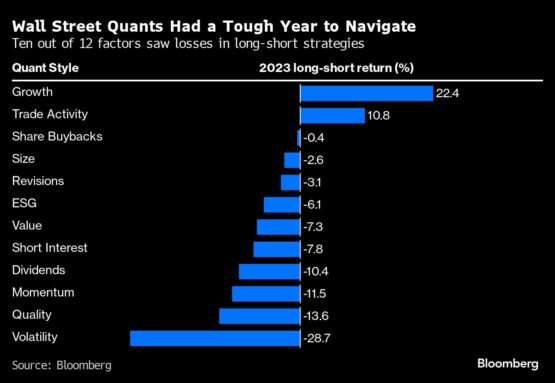Roaring inflation and rapid rate hikes have brought a welcome return of the kind of big swings and dislocations beloved by investing’s smart set, but it hasn’t been a blessing for every breed of quant.
Factor strategies, designed to wring steady money from credit and stock markets by going long and short securities based on traits like how cheap they look or how fast they’ve risen, misfired en masse in 2023.
ADVERTISEMENT
CONTINUE READING BELOW
As assets were lashed by inflation and the craze for artificial intelligence, 10 of 12 long-short factors tracked by Bloomberg lost money in equities. Goldman Sachs Group data show the four main market-neutral strategies in credit all delivered lower returns than cash.
That failure to exceed even risk-free rates is a particular blow to Wall Street’s portfolio wizards, many of whom consider the return on cash a benchmark. The Federal Reserve’s aggressive monetary tightening has ramped up that hurdle, pushing the shortest-dated yields above 5%, up from essentially nothing over the past decade.
“All of a sudden, cash reestablished itself as a competing alternative, certainly to bonds, but also to risk assets,” Lotfi Karoui, Goldman’s chief credit strategist, said in an interview. “It basically set the bar a little too high for systematic strategies to outperform.”
Of course, the challenge is not unique to quants. As much as they like to tout the opportunities thrown up by the return of positive rates, hedge funds of all stripes now have a tougher yardstick to justify their fees and sometimes restrictive terms. While the cash rate has slipped in recent months as inflation cooled, it still hovers near a 22-year high reached in October. Against that backdrop there are incipient signs that investors now expect higher returns and thresholds for performance fees.
Institutions like pensions usually invest in hedge funds with a target return of 3 percentage points on top of the Treasury bill or Libor rate, according to Jon Caplis, chief executive officer of hedge-fund research firm PivotalPath. That now translates to about 8% annually.
The 10 largest cross-asset risk premia hedge funds tracked by Societe Generale SA rose 6% in 2023. Equity hedge funds overall gained 7% in a PivotalPath index.
“You’re not seeing investors want to pull out,” said Caplis. “But you are seeing a number of them starting to ask questions: ‘What am I doing if I’m not generating above cash?’”
For factor investors, the struggle was compounded by the dominance of technology megacaps in last year’s AI-driven frenzy. The Bloomberg GSAM US Equity Multi Factor Index dropped 4.5% for the worst performance since data began in 2007.
Meanwhile in credit, last year marked the first time since at least 2012 when all quant factors tracked by Goldman underperformed cash. At one point about 60% of investment-grade bonds yielded less than cash, making it hard to churn out outsize returns, according to Goldman’s Karoui. Further complicating matters was a sudden shift in market narratives as the focus switched between a recession and a soft landing.
“That’s very difficult considering the many episodes of volatility that we had in 2023,” he said. “It almost created a bit of a smoke screen for the factors.”

ADVERTISEMENT
CONTINUE READING BELOW
The whiplash was particularly painful for a breed of quants known as commodity trading advisers that surf the momentum of asset prices through long and short bets in the futures market. A Bloomberg CTA index dropped 6.8% last year.
That performance is all the more disappointing because CTAs often park large chunks of their assets in interest-earning cash, since their derivative-based bets rarely need to be fully funded. That means returns are a combination of trading profits and interest income, and should theoretically be mechanically higher.
The era of higher rates has been a boon for some systematic strategies and managers. Carry trades — which profit from interest-rate differentials — have seen better returns as spreads widened with borrowing costs, for one. The surge in Big Tech stocks powered the growth factor higher.
Quant giant AQR Capital Management posted a stellar 18.5% return in 2023 on its Absolute Return strategy, which combines its various trades. Izzy Englander’s firm Millennium Management gained about 10%. D.E. Shaw & Co.’s biggest hedge fund returned just under 10%.
Nonetheless, as cash rates have risen, so have investor expectations. A BNP Paribas survey released October showed them targeting annual returns for their hedge-fund investments of 9.75%, up from 6.85% previously. About 90% of investors said the hurdle rate — a threshold managers must cross before charging performance fees — should be anchored to the risk-free rate or a relevant benchmark.
To Neal Berger, founder of Eagle’s View Capital Management, things are already changing. His firm, which advises clients on hedge-fund allocations and runs a multi-manager fund of niche strategies, is now looking for double-digit returns, up from about 8% in the low-rate days.
“There is a viable argument for certain strategies that have become more attractive, that benefit from the higher interest rates,” he said. “But at the end of the day, everybody has to earn a spread above risk-free in order to attract and retain investors.”
© 2024 Bloomberg

